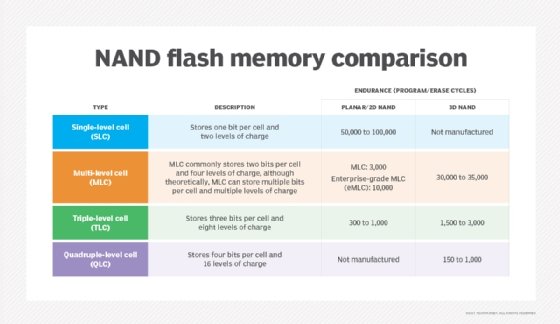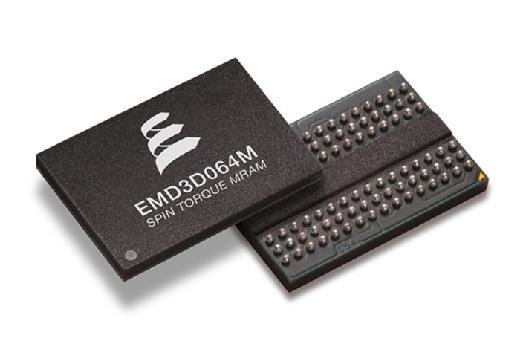non-volatile storage (NVS)
Trends and future directions
Manufacturers are working on additional types of non-volatile storage to try to lower the per-bit cost to store data and program code, improve performance, increase endurance levels and reduce power consumption.
For instance, manufacturers developed 3D NAND flash technology in response to physical scaling limitations of two-dimensional, or planar, NAND flash. 3D NAND can deliver higher densities at a lower cost per bit Over the years, manufacturers have also been increasing the number of bits per cell in NAND flash storage.
- Single-level cell (SLC). Each cell contains only one bit. This configuration is the fastest, most durable and least prone to error. It’s also the most expensive. For mission-critical workloads, however, it might well be worth the price.
- Multi-level cell (MLC). Each cell contains exactly two bits, even though the name indicates otherwise. MLC devices are not as fast, reliable or durable as SLC storage, but they’re more affordable and are well suited for many types of enterprise workloads. MLC devices are what made it possible for standard laptop and desktop computers to start incorporating SSDs, and they’re still used extensively in business computers.
- Triple-level cell (TLC). Each cell contains three bits. The TLC technology sacrifices speed, reliability and durability even further, but it also increases densities and lowers the per-gigaBy increasing the number of bits per cell, flash-based SSDs can hold more data, resulting in lower prices, reduced power consumption and smaller footprints. Multi-cell configurations are also used in conjunction with 3D NAND to increase capacities even further. In addition, manufacturers are actively working on penta-level cell (PLC) flash, which squeezes five bits per cell, although it could still be several years before PLC devices hit the market.
![NAND flash memory comparison]()
Comparing single-level, multi-level, triple-level and quadruple-level cell NAND flash technologies
Manufacturers have also been working on storage solutions that bridge the gap between traditional volatile system memory and flash-based SSDs, providing an additional tier in the storage hierarchy. The most notable effort has been the 3D XPoint project co-developed Intel was the first to offer products based on 3D XPoint, shipping them under the brand name Optane, which includes a line of SSDs and persistent memory modules intended for data center use. Persistent memory modules are also known as storage class memory.
![image of a 3D XPoint technology die.]()
An image of a 3D XPoint technology die.
Non-volatile memory express (NVMe) technology has also proved to be a game-changer in the storage industry. NVMe makes it possible to connect flash-based SSDs directly to a computer’s PCI Express (PCIe) bus, rather than connecting through Serial Attached SCSI (SAS) or Serial ATA (SATA) interfaces. These older technologies were built for slower HDDs and cannot take full advantage of the SSD’s capabilities. NVMe can also be used in conjunction with newer options such as Optane SSDs, further accelerating performance and reducing latency and power consumption.
NVMe offers a more streamlined command set to process input/output (I/O) requests with PCIe-based SSDs than the Small Computer System Interface (SCSI) command set does with SAS drives or the analog telephone adapter (ATA) command set does with SATA drives.
The success of NVMe led to the development of NVMe over Fabrics (NVMe-oF), a specification that was created to support the use of the NVMe command set when transferring data between SSDs and other systems over a network fabric such as Ethernet, Fibre Channel or InfiniBand. According to NVM Express Inc., 90% of the NVMe-oF protocol is the same as basic NVMe.
![Everspin Technologies DDR3 ST-MRAM storage.]()
Everspin’s EMD3D064M 64 Mb DDR3 ST-MRAM in a Ball Grid Array package.
Emerging non-volatile storage technologies currently in development or in limited use include phase-change memory (PCM), ferroelectric RAM (FRAM or FeRAM), magnetoresistive RAM (MRAM), resistive RAM (RRAM or ReRAM) and spin-transfer torque magnetoresistive RAM (STT-MRAM or STT-RAM).



